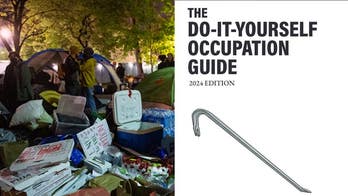
LOS ANGELES, CA - FEBRUARY 05: A sign reading, "Se habla Espanol", identifies a bilingual election official as voters go to the polls for Super Tuesday primaries in the predominantly Latino neighborhood of Boyle Heights on February 5, 2008 in Los Angeles, California. Latinos are an increasingly important factor in California where they are expected to account for 14 percent of the vote and tend to favor presidential hopeful Sen. Hillary Clinton (D-NY) over rival Sen. Barack Obama (D-IL). At 44 million, Latinos make up15 percent of the US population, the nation's largest minority group according to the latest Census Bureau estimates. (Photo by David McNew/Getty Images) (2008 Getty Images)
With polls showing President Obama and Republican challenger Mitt Romney virtually neck and neck, Ohio is looming as a pivotal state.
Obama had kept an edge among voters in this state, where a steadily growing Latino population constitutes three percent of the population. Recent polls showed him leading Romney among Ohio likely voters, 51 to 47 percent.
Romney is campaigning hard in the Buckeye State for the simple reason that no Republican presidential candidate has ever won without Ohio. The former Massachusetts governor and his running mate, Paul Ryan, have made six stops in Ohio in over four days, and Romney said he was extending his swing in the state into the weekend. Ryan is scheduled to campaign there on Saturday.
As close as this race is getting, Latinos can make a difference.
On a recent campaign stop in the state, Romney said: “It’s time for [Obama] to leave the White House. Ohio’s going to elect me the next president of the United States.”
Obama, in Columbus, called out, “All right, Buckeyes, we need you.” His campaign had buses ready to where the rally was, reading to ferry students or other supporters to registration centers.
Ohio is home to about 355,000 Hispanics, the majority of them of Mexican descent. Some 166,000 of them are eligible voters —the 19th largest Hispanic eligible voter population nationally, according to the Pew Hispanic Center.
“While Ohio doesn’t have a significant Latino population, every vote will count,” said Viviana Hurtado, Project Vote spokesperson. “Latinos have lagged in voter registration [nationwide]. In 2008, only half the eligible Latino voters voted.”
Hurtado, who does Latino outreach for Project Vote, is working to persuade Latinos, such as those in Ohio, that a strong turnout by them can make the crucial difference in what is expected to be a tight race.
Wright State University professor Tony Ortiz, who is a member of the Ohio Commission on Hispanic/Latino Affairs, agrees.
"As close as this race is getting, Latinos can make a difference," Ortiz said.
In the future, though, Latinos, who are Ohio’s fastest growing population, have the potential to play a greater role in future presidential elections.
Consider that more than a third of Latino eligible voters are young – 18 through 29. That is greater than Ohio’s general population of voters – 20 percent of whom are in that age range.
Ohio’s Hispanic community accounted for nearly 56 percent of the state’s total growth between 2000 and 2009, according to the 2010 Census. At the same time, the white non-Hispanic population declined by nearly 3 percent.
As in the rest of the country, jobs and healthcare are major concerns for Ohio’s Latinos. The unemployment rate for Latinos has been higher over the years than that of the general population, reaching 16 percent in 2010, according to the Ohio Department of Development.
A third of the state’s Latinos lived under the poverty line, according to the agency, and about a quarter of Latino residents lack health insurance.
Immigration has been an issue, too, though in one particular city the topic took on a different twist.
Responding to years of economic decline, Dayton, Ohio embarked on a campaign in 2011 to attract immigrants to move there and revive the economy.
Meanqhile, Romney’s supporters have been riding the post-debate momentum.
“I promise you he’s back in the game in Ohio,” said Charles Black, an informal Romney campaign adviser.
Some strategists say they see the voter winds starting to blow Romney’s way after his command of the first debate in Colorado – particularly in several battleground states that are expected to decide the election.
“There isn’t any question that he has breathed new life and new energy into the Republican Party,” Ohio Gov. John Kasich said earlier this week on a conference call with reporters. “We’re seeing that there is greater intensity among Republicans and a great willingness to get out and vote and participate than we’re seeing with Democrats.”
On the road to 270 electoral votes needed to win the presidency, the battleground states account for the final 110 electoral votes: Ohio, Florida, Iowa, Nevada, Wisconsin, New Hampshire, Virginia, North Carolina and Colorado.
Ohio has 18 electoral votes. If Romney were to lose Ohio, he would have to carry every other battleground state except tiny New Hampshire.
The campaigns and outside groups spent more than $141 million on TV ads in Ohio through the beginning of October, one of the highest per-person spending rates in the country. Only more-populous Florida, which has seen $150 million in ad spending, has seen a higher total.




